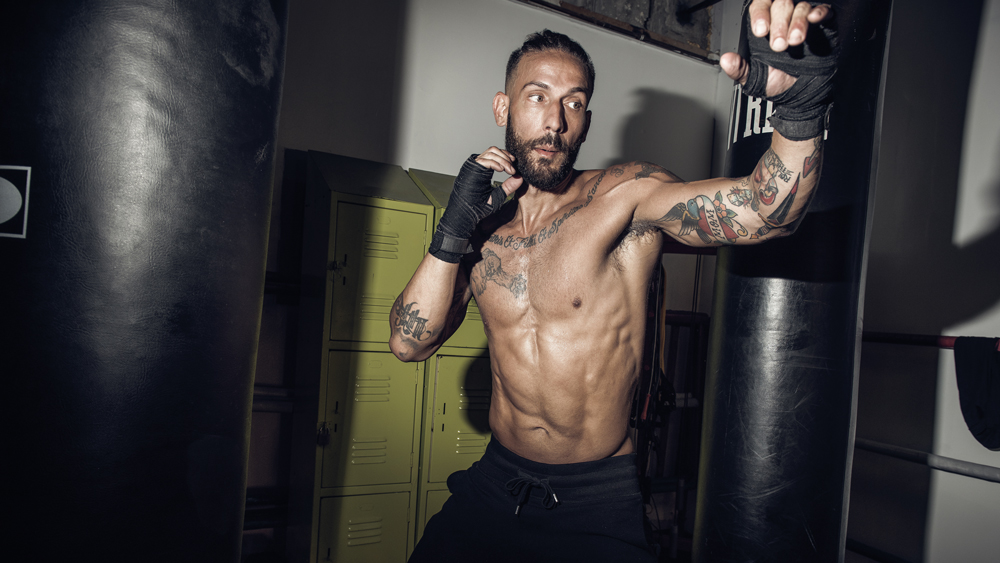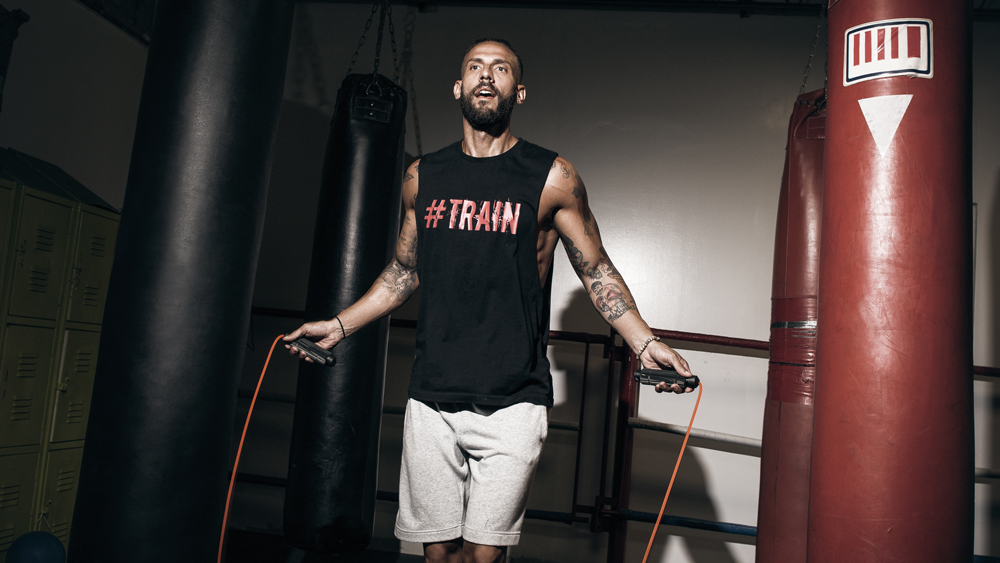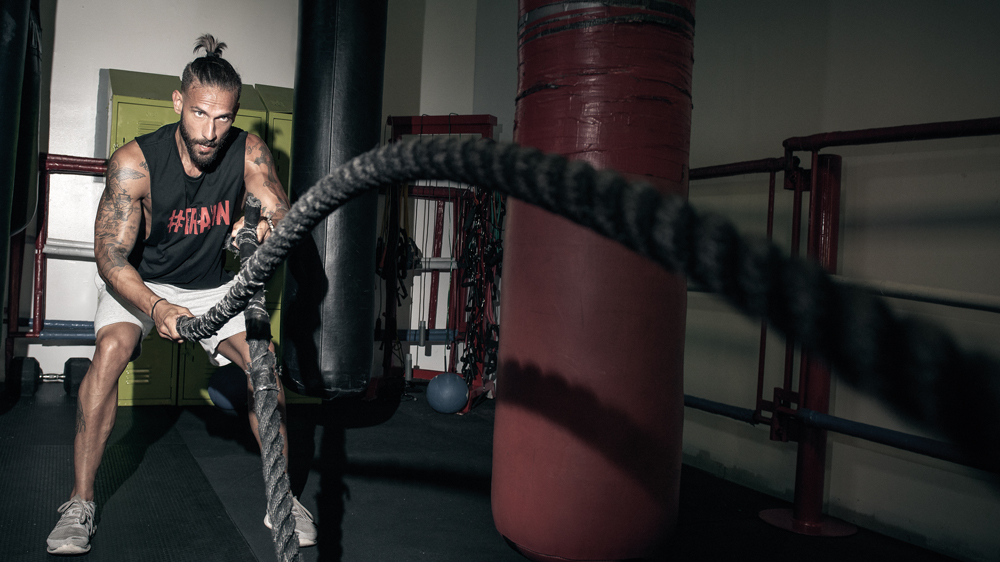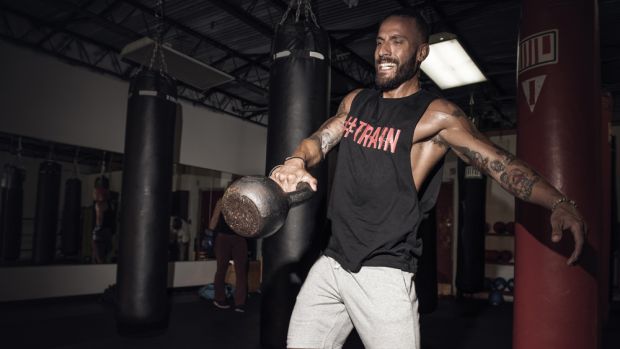How To Get Fit With Boxing Training
If you’re ring-ready, you’ll be prepared for anything. Time to glove up and embrace the sweet science of sweat
Strength? Check. Power? Check. Co-ordination, tenacity and punch-proof, photoshoot-friendly abs? Check, check and double check. If you’re looking for a sport to make all-round improvements to your body, boxing’s for you. With multimillion-dollar purses on the line at every title bout, sports science is doing its utmost to keep pace – which means we know more about how to get fit to fight than ever before.
Not that you need to get punched in the face to get results. But even if you aren’t planning ever to step into the ring, training as if you are will pay off like a title shot in Vegas. According to one study published in the journal BMC Sports Science, doing 12 weeks of high-intensity boxing drills helped reduce subjects’ body fat levels by 13.2%, waist measurements by 5.3% and increase VO2 max – the best measure of cardio fitness – by up to 16%.
And it’s important to get it right. There are boxing workouts in every corner of the web, but the good ones still teach you to keep your chin down and your hands up – and throw a punch like you’re actually planning to hit something. If you want to include striking in your training, you should aim to emulate these. Here you’ll find everything you need to train like a boxer, including drills that build technical expertise as well as your legs and lungs. Ready for round one?
Warm Up With Shadowboxing

It might not feel as immediately satisfying as thumping the bag, but there’s a reason pros put in hours of work solo – it’s one of the fastest ways to get better. With no kit required. “Shadowboxing is a great way to improve technique, condition the muscles for punching, improve your speed, endurance and footwork,” says Adam Willoughby, a personal trainer and former professional muay Thai fighter. “Use it to warm up or down, as well as to mentally prepare for competition.” The trick is to do it mindfully – rather than dancing around throwing endless jabs, imagine you’re reacting to a live opponent who wants to hit you back. When it’s for real, you’ll be glad of the practice.
Get some space – you don’t want to stay in one spot. “Keep punches light and fast while still remembering to transfer your weight through the entire body as you punch,” says Willoughby. “Play out fight scenarios in your head. Think attack/defence with head movement, footwork and counter-punches while keeping your balance. It can seem overwhelming at first, but choose three to four simple combinations and drill them – then add in footwork patterns.”
Round 1: Move your head
In boxing, not getting hit is half the puzzle – and head movement will help. “Practice your weaves on the spot, or on some string or a set of handwraps pulled across the ring,” says Willoughby. “Bob and weave from side to side under the string, transferring weight from your front to back foot, and keeping your torso upright. Once you’re confident doing it statically, start adding some movement forwards and backwards.”
Round 2: Work the jab
Most of your combinations should start with the jab: it’s your fastest, straightest, most reliable punch. “Work on a jab with your lead hand, then throw a cross to follow up,” says Willoughby. “Once you’ve got that, try jab, cross, slip an imaginary cross back, then throw a left hook.”
Get the Coach Newsletter
Sign up for workout ideas, training advice, reviews of the latest gear and more.
Round 3: Use your angles
“Staying static after a shot or combination can leave you vulnerable, so cutting an angle is a crucial skill to learn,” says Willoughby. “Focus on moving, slipping or rolling.” The most basic skill to master is exiting a combination safely: try throwing a jab, right cross, left hook combo, then using your head movement to “roll” right underneath an imaginary left hook – putting you in the perfect position to fight back.
Build Power With The Heavy Bag

There’s good news if you don’t have a partner: everyone from Ali to Tyson put in hours on the heavy bag. “Bag work is a fundamental part of boxing training,” says Willoughby. “It improves speed, power, technique, core stability and movement – especially if you focus on technical proficiency rather than just tiring yourself out.” This isn’t a HIIT session – instead of spaghetti-armed flailing, aim to put in a few quality rounds every time you’re in the gym.
Move your feet
When you’re starting out, practise your footwork for a round or two before you start to throw punches, so you don’t trip over your own feet when the pressure’s on. “Basic footwork is to move the outer leg first in the direction you want to go,” says Willoughby. “Move backwards, forwards and in a circle, keeping your feet roughly the same distance apart all the time. Keep the knees soft to generate more power from the floor through your legs. Don’t cross your feet.”
Manage distance
Get out of the habit of stopping the bag between bursts. “Let the bag dictate your distance,” says Willoughby. “Use head movement while stepping forward to close distance. Work the body when you come in close, then step back out, moving your head.” You’ll build better conditioning and leg endurance, as well as making yourself a more effective fighter.
Go full power
If you want to focus specifically on power, do it near the start of a session, when you’re fresh. After warming up with shadowboxing and a round on the bag, do five to ten full-power punches on each arm, then rest for 60-90 seconds. Repeat four or five times, then move on to more technical work.
RECOMMENDED: Punching-Bag Workouts For The Gym
Improve Speed With Skipping

The basics
Given yourself enough rope? Check by stepping on the centre with one foot: the handles should reach your armpits, but no further. Once that’s sorted, work on making your technique more efficient. Keep your hands by your hips, elbows by your sides and slightly behind you. Stay on the balls of your feet and bounce as little as possible – at first you’ll need to take big jumps to clear the rope, but aim to reduce your height over time.
The double-under
Mastering will let you build better conditioning in less time. Start with the “penguin’ jump: bounce without a rope, double-tapping your thighs with your hands to get the timing down. Done that? Start adding in individual double-unders to your skipping, then doubles, triples… and finally as many as you can.
The Ali shuffle
It’s a show-off classic but it also improves footwork, calf strength, cardio and conditioning. When you get the hang of skipping you’ll find it easier to alternate which foot is ahead on each bounce. As you improve, exaggerate the motion, scissoring your legs forward and back as you jump. Once you’ve nailed it, try to land and take off twice in between each skip.
The figure 8
It’s a Mayweather favourite, and for good reason. Crossing your hands as you skip brings your upper body into the movement, building shoulder endurance and co-ordination as well as letting you shake off the lactic acid during a three-minute round of skipping. Bring the rope behind you as normal, then cross your hands as it moves downwards in front of your body. You should aim to jump the rope just as your hands cross each other.
Slam Your Way To Better Power

You won’t find any archive footage of Rocky Marciano thrashing a set of PVC-clad ropes around his local EasyGym – but training techniques move on, and change is a good thing. In a 2015 study, battle ropes beat every other bodyweight movement for an all-day metabolic burn.
Their full-body demands also make them ideal for fighters – if you target the right areas. Choose your style and do five to ten minutes of the prescribed exercise, in the work/rest ratios shown.
30/30 arm waves for boxing
Keeping the rest of your body still, wave the ropes as fast as possible, focusing on high reps and high amplitude. You’ll build the arm and shoulder endurance you need to keep your hands up for the full 12 rounds.
15/45 jump smashes for Muay Thai
Jump up and bring both ropes down together, aiming for amplitude. Repeat with as much height and velocity as you can manage – it’s only 15 seconds, and you’ll build nasty kicking power.
20/40 burpee slams for MMA
Getting down and then up is the killer in MMA – the sprawl-and-brawl strategy’s effective but exhausting. Prep with this: drop to the deck, do a press-up, then get back to your feet, jump and slam the ropes.
Get Better Conditioning With Kettlebells

Russian bodybuilders were using them a century ago, but now they’re a staple in fight gyms – for good reason. “Kettlebells are great for improving combat strength and conditioning because they allow you to add resistance through a range of dynamic movements,” says Charlie Watts, a trainer at Workit.London and former MMA fighter.
“During a fight, most moves require whole-body strength and power so training single-muscle, isolation movements isn’t ideal. This complex includes a squat, a push, a hinge and a loaded carry, which will help improve your total body strength endurance and your conditioning. Lift explosively - speed kills in the fight game.” Do four sets, with 45-60 seconds of rest in between.
Goblet squat
12 reps
Hold the bell by the horns. Drop into a squat until your elbows brush your knees, then drive through your heels to stand up.
Clean and press
12 reps each side
Starting with the bell on the floor, lift it up and pop your hips forward, punching your hand underneath to catch the weight on your forearm. Do a quarter-squat, and use the momentum to help press the bell overhead.
Swing
12 reps
Swing the kettlebell between your legs, then pop your hips forward explosively, using the force to drive bell up to shoulder height while keeping your arms relaxed. Tense slightly at the end of the move, as if you were landing a punch.
Kettlebell crosswalk
50 metres
Hold the kettlebell overhead with one arm, and walk with it to improve your oblique strength and rotator cuff stability. If you’ve got a second bell, hold the heavier one in the other hand like a suitcase.
RECOMMENDED: Kettlebell Workouts For Strength, Cardio And Fat Loss
Build Endurance With Your Bodyweight
Modern boxers aren’t afraid to hoist heavy iron, but for decades pugilists got in shape with nothing but bodyweight. It still works, says Watts. “Adding in some bodyweight conditioning at the end of your workout is a great way to supercharge your fight training, improve body control and help build a rock-solid core.” Do five sets of the circuit below, resting for one minute between rounds. “Finish strong with the burpees to build your mental capacity,” says Watts. You don’t want to be the guy praying for the bell.
Pull-up
6-8 reps
Start with your hands facing away from you, and pull until your chin’s over the bar. Lower until your arms are straight.
Press-up
15 reps
Build your triceps by keeping these strict - elbows to your sides, chest to the floor at the bottom of the move, straight arms at the top. Keep your abs braced.
Reverse lunge
10 reps each side
Step backwards into a lunge, dropping down until your knee brushes the floor. Then stand straight back up and repeat on the other leg.
Burpee
10 reps
Drop into a crouch, then kick your legs backwards into a press-up position. Pop back up into the crouch, then jump straight up off the floor and clap overhead to finish the move. Make them count.
Build A Hard Core With Anti-Rotational Moves
The old-school image of a fighter doing thousands of crunches? Outdated. “You need to be strong in each plane of movement – strengthening yourself to move faster, or punch and kick harder, should also include anti-rotational exercises,” says Watts. “This will build the core strength you need to generate serious power, as well as resisting movements that might cause you injury. This mini-circuit contains three unilateral movements with an outside force trying to rotate or twist you while you resist.” Do three sets with 60 seconds of rest after your training session, twice a week.
Shoulder tap
20 reps
Get into the top position of a press-up, core braced. Take one hand off the ground to tap your shoulder, and then the other. Try to keep your torso stable throughout.
Stability press
Position yourself perpendicular to a cable machine (you can also use a rubber band wrapped around an anchor point) and slowly press the cable away from your chest. You’ll feel the centrifugal force try to pull you around. Resist, and keep the reps slow.
Bird dog
10 reps each side
Get on your hands and knees, then slowly bring one arm up and forwards while bringing the opposite leg up and back. Straighten both, pause, then return to the start position and repeat on the other side.
Rip it good
Aiming to get more power into your shots? Your five-point plan is below
Twist
“Focus on a long jab and cross. Fully extend your arm with each shot, and pull the opposite shoulder back when punching,” says Willoughby. “This’ll help you generate power and rotation through your core.” Imagine you’re grinding out a cigarette on the ground with your rear foot – it’ll help you get the twist you need.
Relax
Sounds counterintuitive? Find a Roy Jones Jr highlight reel, and watch how chilled out this great is before throwing his shots. “Relax your arms,” says Willoughby. “Power comes through the transfer of body weight, along with core engagement and rotation of shoulders, knees and ankles. It’s also important to hit with the first two knuckles of each hand.”
Throw
Want to throw harder shots? Medicine ball wall throws teach the right dynamics. Grab a 3-5kg ball, stand in your normal fight stance and throw it against the wall with your rear arm, using a straight-arm throw with the same back-foot pivot as you use for your punches. For hooks, throw the ball like a rugby pass.
Hammer
If you can source a sledgehammer and a tyre, it’ll help you build strength across all the same core muscles that let you throw a knockout shot. Start with your hands wide on the handle, then “choke up” with your lead hand as you swing. Go for quality, not quantity: five sets of ten swings on each side is enough to build power.
Jump
Every good punch starts in the legs, so building up your fast-twitch fibres is the smart way to make big returns fast. Add box jumps to your sessions when you’re still fresh: warm up with two 60-second bursts of skipping, then go for two sets of five explosive jumps onto a 24in (61cm) box. Bonus: it’ll neurally wake you up for the rest of the session.
From 2008 to 2018, Joel worked for Men's Fitness, which predated, and then shared a website with, Coach. Though he spent years running the hills of Bath, he’s since ditched his trainers for a succession of Converse high-tops, since they’re better suited to his love of pulling vans, lifting cars, and hefting logs in a succession of strongman competitions.

